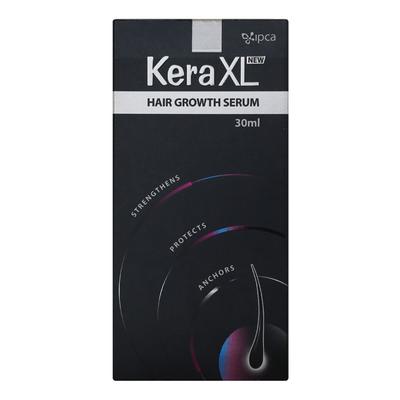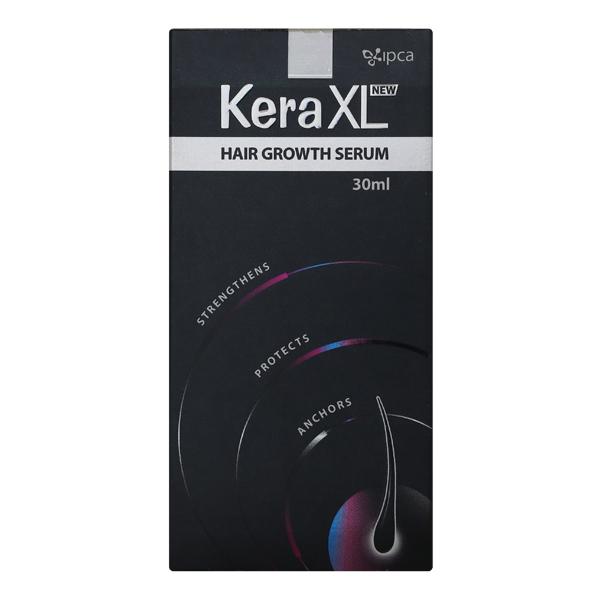

Netmeds First Membership
Quick Links
Introduction About KERA XL NEW HAIR GROWTH SERUM
Kera XL New Hair Growth Serum is used to promote hair density and volume and helps to manage hair loss. It increases the blood flow to the scalp and nutrients to hair follicles and results in thick and healthy hair. It contains Trifolium Pratense (Clover) Flower Extract, AcetylTetrapeptide-3, Butylene Glycol, Dextran, L-Arginine, Propylene Glycol, Lactic Acid, Choline Chloride, d-Biotin, d-Panthenol, Xylitylglucoside, Anhydroxylitol and Xylitol and Polysorbate 80
Trifolium Pratense (Clover) Flower Extract is a source of Biochanin-A that topically inhibits 5-alpha reductase enzymes, responsible for patterned baldness. AcetylTetrapeptide-3 stimulates extracellular matrix protein responsible for hair anchoring and reduces micro-inflammation responsible for hair damage. L-arginine, a conditionally essential amino acid as well as biotin penetrates, nourishes, and energises each hair follicle from the inside out, thus helping to strengthen the hair follicle. D panthenol acts as a moisturiser and also possesses anti-inflammatory properties which relieve scalp itchiness and promote healing.
Always apply Kera XL New Hair Growth Serum as advised by your physician. It is for external use only. Shake well before use. Pump out the serum on the palm and massage over the scalp with your fingertips. Do not use if you are allergic to any of its components.
Key Composition
- Trifolium Pratense (Clover) Flower Extract
- AcetylTetrapeptide-3
- Butylene Glycol
- Dextran
- L-Arginine
- Propylene Glycol
- Lactic Acid
- Choline Chloride
- d-Biotin
- d-Panthenol
- Xylitylglucoside
- Anhydroxylitol and Xylitol
- Polysorbate 80
Therapeutic Uses Of KERA XL NEW HAIR GROWTH SERUM
- Promotes hair density and volume
- Helps to manage the hair loss
- Increases the blood flow to scalp and nutrients to hair follicles
- Results in thick and healthy hair
Side Effects Of KERA XL NEW HAIR GROWTH SERUM
Consult your doctor if you notice any unusual side effects while using Kera XL New Hair Growth Serum
Safety Advice
- Always apply Kera XL New Hair Growth Serum as advised by your physician
- It is for external use only
- Shake well before use. Pump out serum on the palm and massage over the scalp with your fingertips
- Do not use Kera XL New Hair Growth Serum if you are allergic to any of its components
- Inform your doctor on all the other hair care products you are using and herbal supplements
More Information
- Keep Kera XL New Hair Growth Serum out of reach of children
- Store at a temperature below 30°C
FAQs About KERA XL NEW HAIR GROWTH SERUM
Q: How do you use Kera XL New Hair Growth Serum?
A: Always apply Kera XL New Hair Growth Serum as advised by your physician. It is for external use only. Shake well before use. Pump out the serum on the palm and massage over the scalp with your fingertips.
Q: What are the uses of Kera XL New Hair Growth Serum?
A: It is used to promote hair density and volume and helps to manage hair loss. It increases the blood flow to the scalp and nutrients to hair follicles and results in thick and healthy hair.
Q: Can I apply Kera XL New Hair Growth Serum to the wet hair?
A: You should always apply the Kera XL New Hair Growth Serum to damp hair rather than wet hair.
Q: What are the side effects of the Kera XL New Hair Growth Serum?
A: It has no reported side effects, consult your doctor if you notice any unusual side effects while using Kera XL New Hair Growth Serum
Q: What are the benefits of Trifolium Pratense (Clover) Flower Extract in Kera XL New Hair Growth Serum?
A: Trifolium Pratense (Clover) Flower Extract is a source of Biochain-A that topically inhibits 5-alpha reductase enzymes, responsible for patterned baldness.
References
1. https://www.ipca.com/pharmaceutical-formulations-manufacturers-india/
2. https://www.webmd.com/connect-to-care/hair-loss/does-biotin-really-prevent-hair-loss#:~:text=Biotin%2C%20also%20known%20as%20vitamin,it%20needs%20to%20be%20consumed
3. https://pubchem.ncbi.nlm.nih.gov/compound/Dexpanthenol
4. https://www.ncbi.nlm.nih.gov/pmc/articles/PMC6574915/








